Confused between pull ups and chin ups? Whether you are a beginner or an intermediate lifter, it is important to understand some of the key differences between the chin up and the pull up.
Both exercises target the same muscle groups, but with subtle differences in technique and grip.
Get ready to know the key difference between the two and to tone your bicep and back with a classic exercises.
Let know which one will come out on top as the ultimate upper body workout. Chin ups vs Pull Ups.
In this article, you will learn the following:
- What Are Chin Ups and Pull Ups
- Muscle Worked During Chin Ups
- Muscle Worked During Pull Ups
- How to Do Chin Up and Pull Up
- Tips and Technique
- Which Variation is Right for You?
- Benefits of Doing Chin Ups & Pull Ups
- Variations and Modifications
- FAQs

- What Are Chin Ups and Pull Ups
- Muscle Worked During Chin Ups
- Muscle Worked During Pull Ups
- How to Properly Perform a Chin Up
- How to Properly Perform a Pull Up
- Tips and Technique of Doing Chin and Pull Ups
- Pull-ups vs. Chin ups: Which Variation is Right for You?
- 1. Difficulty
- 2. Effectiveness
- 3. Best Option For You
- Benefits of Doing Chin Ups and Pull Ups
- 1. Targeting the biceps and back
- 2. Improving grip strength
- 3. Improving posture
- 4. Improving shoulder mobility
- 5. Building upper body strength
- 6. Cardiovascular fitness
- 7. It can be done anywhere
- Chin up and Pull up Variations and Modifications
- 1. Band assisted Chin-ups and pull-ups
- 2. Wide Grip Pull Ups
- 3. Close-grip pull-ups
- 4. Neutral Grip pull-ups/chin up
- 5. Mixed-grip pull-ups and Chin Up
- 6. Weighted Pull-ups and Chin up
- 7. L Sit Chin Up & pull-ups
- 8. Hockey Grip Chin-ups
- 9. Chin Up and Pull Ups negatives
- 10. Archer Pull up
- FAQs
- Chin up works what muscles
- Pull up works what muscles
- Chin ups vs pull ups which is harder
- What’s better chin ups or pull ups
- Are chin ups and pull ups the same thing?
- Takeaways
- References
- 12 Different Types Of Pull Ups and Chin Ups
What Are Chin Ups and Pull Ups
Chin ups and pull ups are often used interchangeably, however they do have some differences.
Chin ups and pull ups are both exercises that target the upper body, specifically the back muscles such as latissimus dorsi, trapezius, rhomboids and shoulders, and arms.
They are both performed using a pull-up bar, and the main difference between the two exercises is the grip used.
- A chin up is an exercise where the palms facing towards the body (underhand or supinated grip) while gripping the bar. This grip targets the biceps more than the back and shoulders.
- A pull up is an exercise where the palms facing away from the body (overhand or pronated grip) while gripping the bar. This grip targets the back and shoulders more than the biceps.
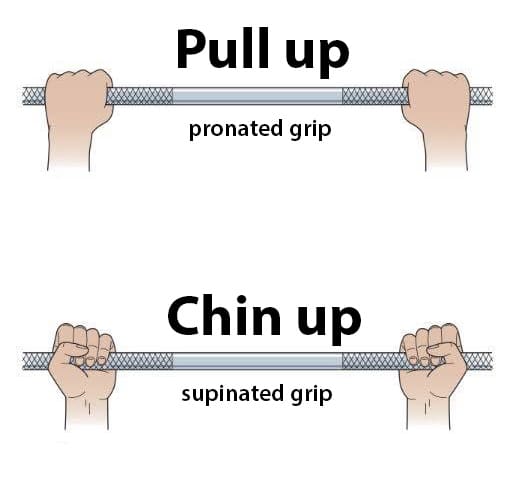
Muscle Worked During Chin Ups
Chin ups primarily work the biceps, but also involve several other muscle groups in the upper body.
The main muscles worked during chin ups are, Biceps, brachialis, Brachioradialis and Latissimus dorsi
Other Synergists muscles worked during chin ups are, rear deltoid, rhomboids, Levator Scapulae, Trapezius muscle groups, pectoralis major, erector spinae, Infraspinatus

Muscle Worked During Pull Ups
Pull ups primarily work the back, but also involve many other muscle groups in the upper body.
The main muscle worked during pull ups is Latissimus dorsi.
Other Synergists muscles worked during pull ups are, Biceps, brachialis, Brachioradialis, Rear deltoid, rhomboids, Levator Scapulae, Trapezius muscle groups, Pectoralis Major, erector spinae, Infraspinatus.
Compared to a chin-up, pull-ups better engage the lower trapezius muscles.
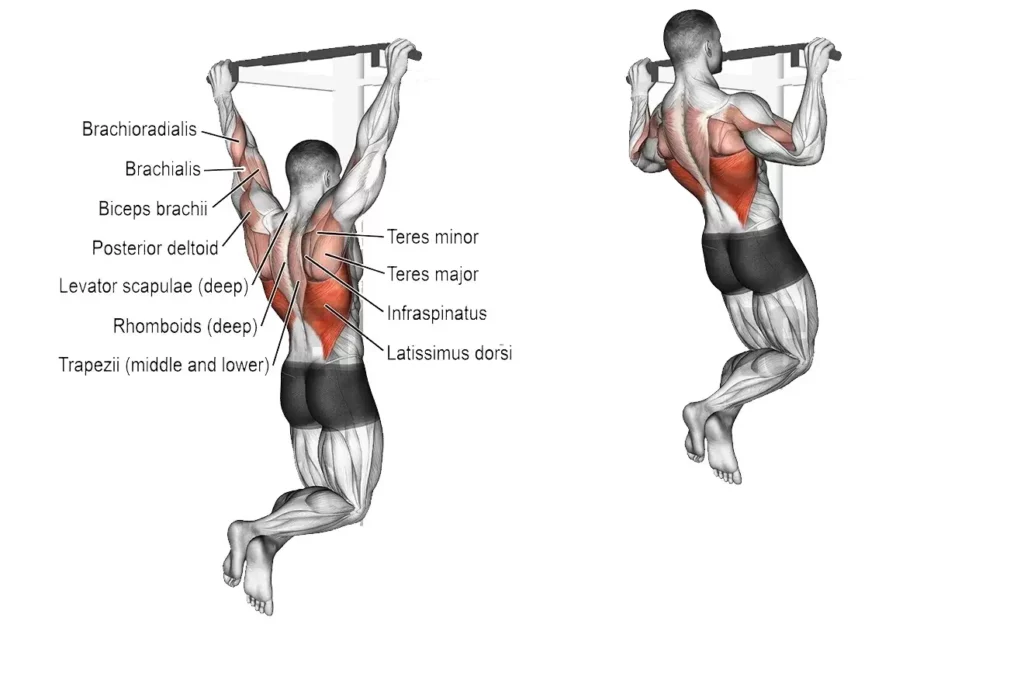
In one of the study, electromyographic (EMG) activation of back, shoulder, arm, and abdominal musculature measured and expressed as a percentage of maximum voluntary isometric contraction (MVIC) during a pull-up, chin-up, or rotational exercise with Perfect Pull-up twisting handles.
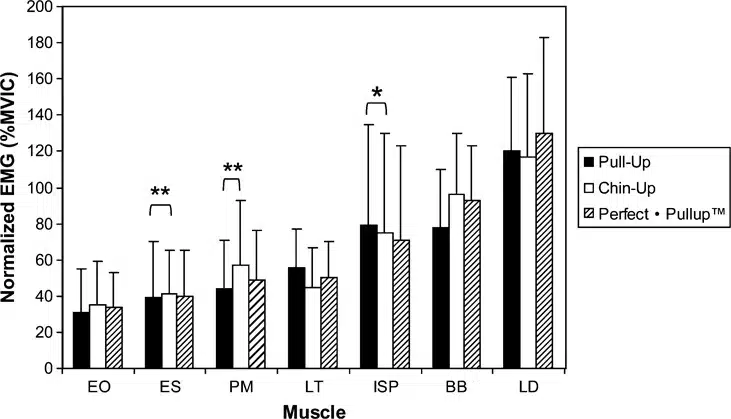
The muscles are:
- External oblique (EO)
- Erector spinae (ES)
- Pectoralis major (PM)
- Lower trapezius (LT)
- Infraspinatus (ISP)
- Biceps brachii (BB)
- Latissimus dorsi (LD)
The authors noted that the biceps brachii and pec major were more active during the chin up compared to the pull-up, while the back and lower traps were more active during the pull-up.
Note: In this study, the difference in muscle activation between chin ups and pull ups is surprisingly small.
Another useful paper to look at for assessing the muscles worked in the chin up and pull-up is Electromyographic analysis of muscle activation during pull-up variations.
How to Properly Perform a Chin Up
To perform chin ups correctly, follow these steps:
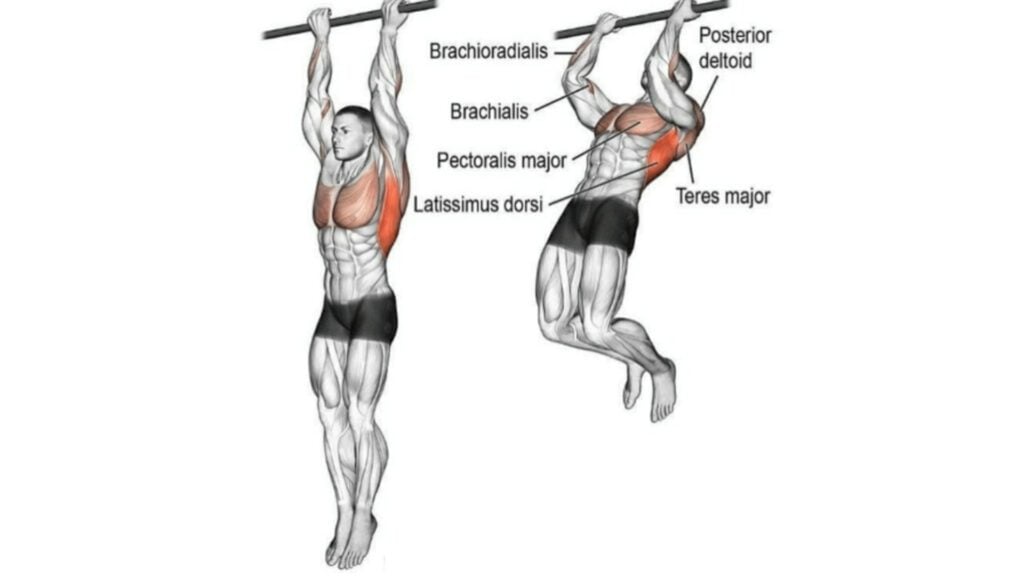
- Grip the pull-up bar with your palms facing towards you and use a narrow grip.
- Hang from the bar with your arms fully extended and shoulders pulled down and back.
- Engage your core and keep your body in a straight line from your head to your heels.
- Pull your body up towards the bar by flexing your elbows and bringing your chest towards the bar.
- Keep your elbows close to your body as you pull yourself up.
- Once your chin is above the bar, hold for a moment and then lower yourself back down slowly.
- Repeat for the desired number of reps.
Start with a lower number of reps and work your way up, as chin ups can be difficult for beginners.
How to Properly Perform a Pull Up
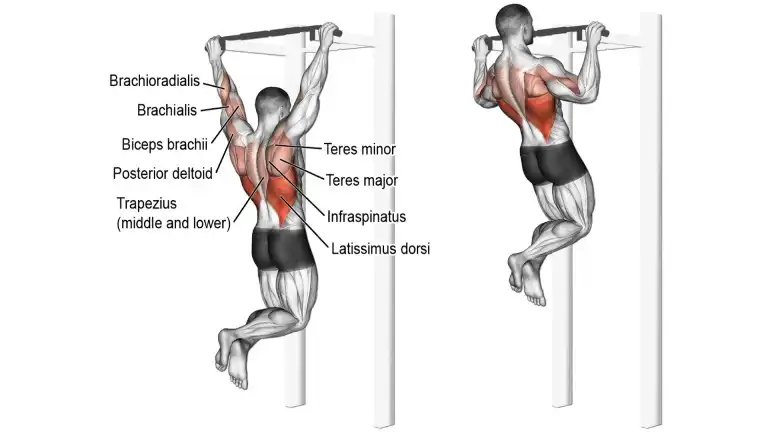
To perform pull ups correctly, follow these steps:
- Grip the pull-up bar with your palms facing away from you at shoulder width.
- Engage your core and keep your body in a straight line from your head to your heels.
- Pull your body up towards the bar by flexing your elbows and bringing your chest towards the bar.
- Keep your elbows close to your body as you pull yourself up.
- Once your chin is above the bar, hold for a moment and then lower yourself back down slowly.
- Repeat for the desired number of reps.
Know More: 15 Best Bodyweight Back Workout: Beginner to Advanced
Tips and Technique of Doing Chin and Pull Ups
Here are some tips and techniques for performing chin ups and pull ups correctly:
- Make sure to grip the bar firmly, but not too tightly, to avoid straining your hands and wrists.
- Keep your shoulders pulled down and back, and avoid shrugging them up to your ears.
- Keep your body in a straight line from your head to your heels, and avoid swinging.
- Keep your elbows close to your body, and avoid flaring them out to the sides.
- Use a slow and controlled motion when performing the exercise.
- Always warm up your muscles before performing chin ups or pull ups, to avoid injury.
- Start with a lower number of reps and work your way up, as well as incorporating other upper body exercises into your workout routine to target different muscle groups.
- Incorporate different types of chin ups and pull ups, such as wide grip, close grip, or neutral grip, to target different muscle groups and avoid hitting a plateau.
- If you are struggling with pull ups or chin ups, you can use an assisted pull-up machine, resistance band or have a partner assist you by holding your legs while you perform the exercise.
Pull-ups vs. Chin ups: Which Variation is Right for You?
A study has shown that pull ups and chin ups are both effective exercises for building upper body strength. However, there are some key differences between the two exercises that may make one variation more suitable for you than the other.
1. Difficulty
Chin ups are generally considered to be slightly easier than pull ups. This is because the supinated grip used in chin ups allows for more bicep activation, which can help to offset the weight of your body. Pull-ups, on the other hand, require more latissimus dorsi activation and are therefore more difficult for many people.
The wider pronated grip of pull-ups also provides less mechanical advantage than the narrow supinated chin up grip. More muscle contraction is needed to move through the full range of motion during pull ups.
2. Effectiveness
Both pull-ups and chin ups are effective for building upper body strength.
- Pull ups may be a better choice for people who are specifically looking to target their lats.
- Chin ups, on the other hand, may be a better choice for people who are looking to build their biceps.
3. Best Option For You
The best way to figure out which option is best for you is to try both and see which one you like better.
If you are new to pull ups or chin ups, it is a good idea to start with a modified version, such as a negative pull up or a band-assisted chin up. It will help you build strength and technique before you attempt a full pull-up or chin up.
Benefits of Doing Chin Ups and Pull Ups
Chin ups provide greater activation of the arm muscles and back, and thus can be beneficial if you are looking to strengthen your upper body.
1. Targeting the biceps and back
The biceps are the primary muscle group targeted during chin ups. And during pull ups that help build muscle mass and increase strength in the back and biceps.
2. Improving grip strength
Regularly performing chin ups can help improve grip strength, which can carry over to other exercises and activities.
3. Improving posture
Pull ups and chin up help to strengthen the muscles of the upper back, which can improve posture and reduce the risk of back pain.
4. Improving shoulder mobility
Chin ups and pull ups involve a good range of motion of the shoulder joint, as you are pulling yourself up to the bar, which can help in improving the shoulder mobility.
5. Building upper body strength
Chin ups improve your overall upper body strength by working several muscle groups in the upper body, including the back, shoulders, and arms.
6. Cardiovascular fitness
It is a compound exercise that requires a lot of energy and effort, which can improve cardiovascular fitness and endurance.
7. It can be done anywhere
Chin ups can be done with a pull-up bar, which can be installed at home, gym or even in a playground, making it a convenient and accessible exercise.
Chin up and Pull up Variations and Modifications
Once you’ve mastered the chin up and pull up, you can start doing more variations that match your strength goals.
Here are some great chin-up and pull-up variations to help you build strength, power, and muscle.
1. Band assisted Chin-ups and pull-ups
Band assisted chin-ups and pull-ups are a variation that uses a resistance band to provide assistance during the exercise.
This variation can be helpful for beginners or those looking to increase the number of reps they can perform.
It can also be used as a way to progress towards unassisted chin-ups and pull-ups.
The amount of assistance can be adjusted by using a band with different resistances or by adjusting the position of the band.
2. Wide Grip Pull Ups
During wide-grip pull-ups, the hands are positioned wider than shoulder-width apart on the bar.
This grip variation allows for a greater range of motion and increased muscle activation in the upper back and lats.
It also helps to improve grip strength and work on the back muscles.
3. Close-grip pull-ups
When performing Close grip pull-ups, the hands are placed closer than shoulder-width apart on the bar.
This grip variation increases the activation of the biceps and forearms, and can help to improve grip strength.
It can also be used as a way to vary your exercise routine and target different muscle groups.
It’s important to use proper form and not to grip too close to avoid unnecessary stress on the wrist.
4. Neutral Grip pull-ups/chin up
In neutral-grip pull-ups, the hands are positioned with a parallel grip (palms facing each other) on the bar or a parallel bar.
This grip variation puts less stress on the shoulder, and also works on the biceps and forearms.
Neutral grip pull/chin up variation can be useful for those who have shoulder injuries or pain, as it can be less stressful on the shoulder joint.
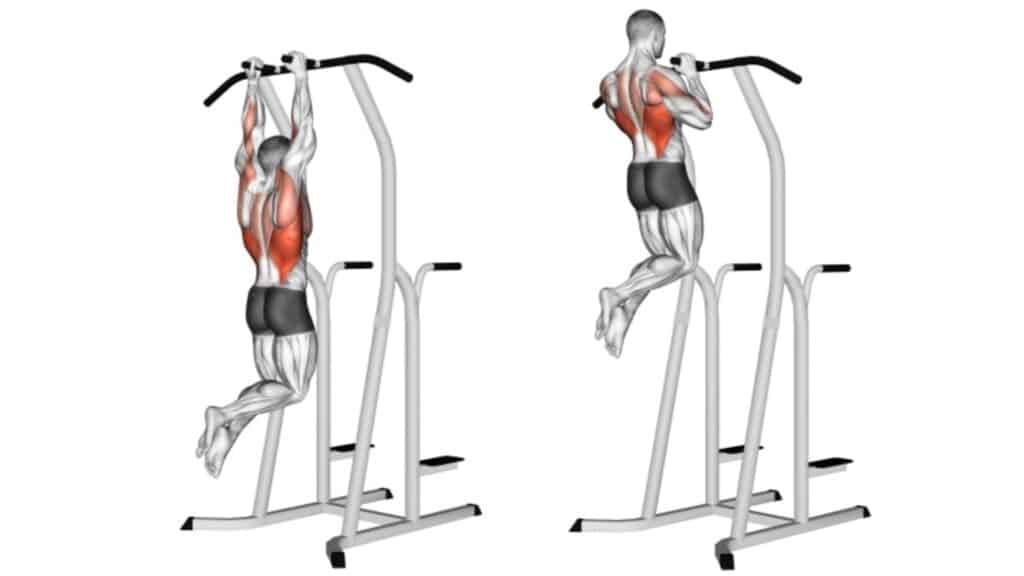
5. Mixed-grip pull-ups and Chin Up
In this variation, one hand is positioned with an overhand grip (palms facing away from the body) and the other hand is positioned with an underhand grip (palms facing towards the body) on the bar.
However, due to the asymmetrical nature of the exercise, it can put extra stress on the shoulder.
It is important to be careful with the form and not to overdo it.
6. Weighted Pull-ups and Chin up
In weighted pull-ups and chin ups, additional weight is added to the body during the pull-up, typically in the form of a weight belt or a dumbbell held between the legs.
The added weight increases the resistance and the difficulty of the exercise.
It’s a great way to progress from bodyweight pull-ups and chin up and to increase the intensity of the workout.
It’s also important to have a strong base of bodyweight pull-ups before attempting this variation.
7. L Sit Chin Up & pull-ups
In this variation, the individual performs a pull-up while maintaining an L-sit position (legs extended out in front of the body at a 90-degree angle).
It’s a challenging exercise that can help to increase core strength, stability and upper body strength.
It’s also a great way to progress from traditional pull-ups and chin up.
8. Hockey Grip Chin-ups
Hockey-grip chin-ups are similar to the close-grip chin-ups, but with a more specific grip.
In this variation, the hands are positioned with a narrow grip, mimicking the grip of a hockey stick, with the palms facing away from the body.
It emphasizes more on the biceps and forearms than the back. It can also be a great way to improve grip strength and endurance.
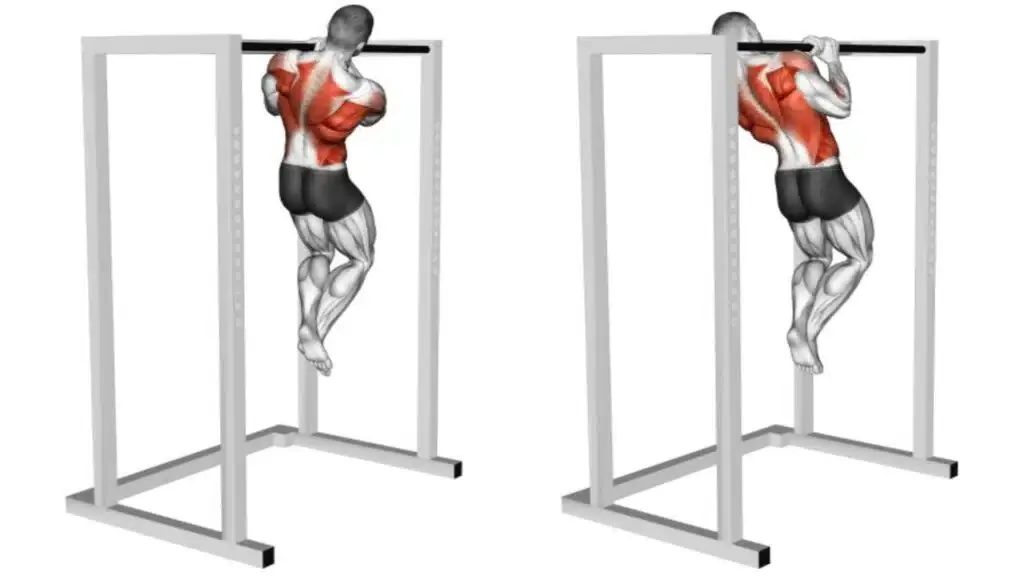
9. Chin Up and Pull Ups negatives
Negative Chin-ups, also known as “eccentric chin-ups”, are a variation of chin-ups that focus on the eccentric (lowering) portion of the movement.
In this variation, the individual uses a step or a partner to help them jump or lift themselves to the top position of the chin-up or pull, and then slowly lower themselves down over a period of several seconds.
This can be a great way to increase muscle activation and strength in the upper back, lats, and biceps, as the eccentric portion of the movement is typically where the muscle is under the most tension.
Additionally, since the negative portion is slower, it creates more time under tension, and can be more effective for muscle growth.
10. Archer Pull up
Think of an archer pull up almost like a self-assisted one-arm pullup. It’s a great way to dramatically increase the intensity of a standard pullup without the need to add weight
This variation requires stability and balance, making it a challenging exercise for the core as well as the upper body.
Note: Prior to attempting the advanced variations, it is recommended that you master the basics of chin-up and pull-ups.

FAQs
Chin up works what muscles
Chin-ups primarily work the biceps brachii, latissimus dorsi, and brachialis muscles. They secondarily work the forearm flexors, trapezius, rhomboids, posterior deltoids, and core muscles.
Pull up works what muscles
Pull-ups primarily work the latissimus dorsi, trapezius, and rhomboid muscles in the back. They also engage the biceps brachii, brachialis, and rear deltoids as secondary movers.
The pronated grip works the lats more than chin-ups, which means that the back and shoulders get stronger. The core is activated to stabilize the body during the movement. Other muscles worked include the forearm muscles.
Chin ups vs pull ups which is harder
Pull ups are considered to be harder than chin ups. This is because pull ups primarily target the back muscles, which are often weaker than the biceps.
Additionally, the hand position during pull ups puts the biceps in a weaker mechanical position, making the movement more challenging.
Also, the grip during pull ups is more challenging as the palms face away from the body, which requires more grip strength.
However, this does not mean that chin ups are easy, it’s still a challenging exercise that requires upper body strength, core stability and proper form.
What’s better chin ups or pull ups
Both chin ups and pull ups are excellent exercises for building upper body strength and muscle mass.
- Chin ups target the biceps, shoulders, and back muscles, and also work the core and forearms as stabilizing muscles.
- On the other hand, pull ups target the back muscles (lats, upper back) and also engage the shoulders, biceps, forearms, and core.
The best exercise for you depends on your personal fitness goals and which muscle groups you want to focus on.
Are chin ups and pull ups the same thing?
No, chin ups and pull ups are not the same thing.
Chin ups involve gripping the pull-up bar with the palms facing towards you, while pull ups involve gripping the pull-up bar with the palms facing away from you.
The hand position during chin ups allows the biceps to work in a stronger mechanical position, making the movement less challenging than pull ups.
Takeaways
Chin ups and pull ups are both effective exercises for building upper body strength and muscle mass. However, they target different muscle groups.
Both exercises are challenging, but chin ups may be more accessible for beginners due to the hand position and the fact that biceps are typically stronger than the back muscles.
Pull ups, on the other hand, require more grip strength and are considered harder.
It’s beneficial to include both chin ups and pull ups in your workout routine for overall muscle development and to avoid hitting a plateau.
References
- James W Youdas Collier L Amundson, Kyle S Cicero, Justin J Hahn, David T Harezlak, John H Hollman: Surface electromyographic activation patterns and elbow joint motion during a pull-up, chin-up, or perfect-pullup™ rotational exercise. J Strength Cond Res 2010 Dec.
- Dickie JA, Faulkner JA, Barnes MJ, Lark SD. Electromyographic analysis of muscle activation during pull-up variations. J Electromyogr Kinesiol. 2017 Feb
12 Different Types Of Pull Ups and Chin Ups

Manish brings over 10 years of hands-on experience in weight lifting and fat loss to fitness coaching. He specializes in gym-based training and has a lot of knowledge about exercise, lifting technique, biomechanics, and more.
Through “Fit Life Regime,” he generously shares the insights he’s gained over a decade in the field. His goal is to equip others with the knowledge to start their own fitness journey.

Great article! Many people, whether beginners or advanced lifters, still don’t know the difference. I appreciate this high quality and in depth comparison.
Thank You.
I loved this. It was exactly what I was looking for and more. Thank you.
Thanks